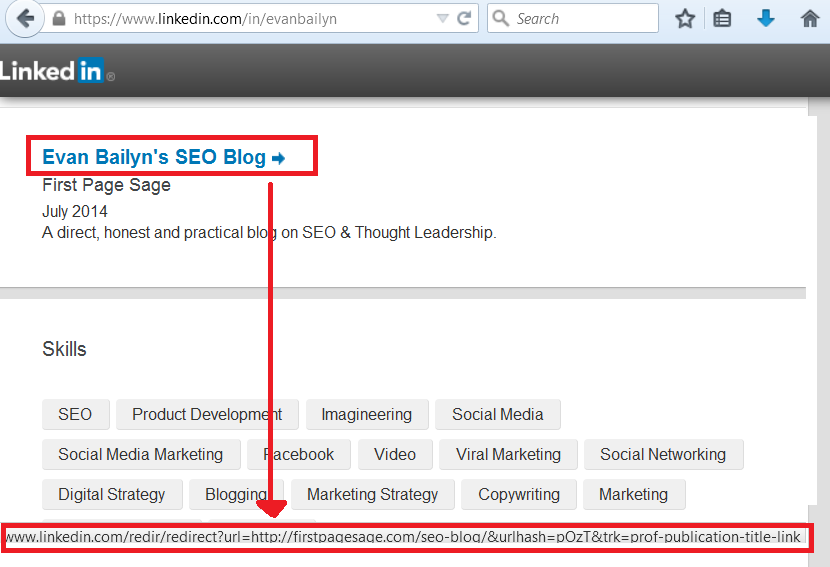When browsing around online, we frequently see articles that use the words “LinkedIn” and “SEO” in the same sentence. We find that unusual, so we looked into what people are claiming to be the relationship between the world’s largest business social network and the practice of optimising a website to the top of a search engine’s results.
It seems that people are using the word “SEO” to mean showing up in any search tool’s results, including LinkedIn’s own search tool. This is a very valid subject – for many people, having your profile appear highly when decision makers input a search related to your expertise is very valuable – but it’s still not technically “SEO”.
And in fact, SEO and Linkedin have almost no relationship.
Here’s why: for a website to have a positive impact on your website’s Google rankings, it needs to pass “TrustRank” (the currency of Google’s trust) to another website. TrustRank is passed when a webmaster places a clickable link on their website that points to your website. When a webmaster (usually a blogger) links to your website, it’s the equivalent of earning a vote in an election. And in the world of Google, the website that has the greatest number of high-quality links pointing to it gets to the top of the list. So, if your website is written up in the Huffington Post, and there is a link to it in the story (which there nearly always will be), it’s as if the Huffington Post has endorsed your site. Enough links and your site will start ranking highly for its main keywords.
The reason Linkedin doesn’t play well with SEO is that all of LinkedIn’s outbound links are intentionally stripped of all their TrustRank. So when you place a link back to your own website in your LinkedIn profile, it has as much value in Google’s eyes as no link at all. This is called a “nofollow” link. Here’s how you can see this phenomenon in action:
Try going to a link on LinkedIn that points to an outside website. Roll your mouse over it, then look at the bottom of your browser, where the URL of the link is displayed. You’ll find that rather than seeing the website’s address displayed normally, the link has been changed to a URL at linkedin.com/redir. This means that Google is sending visitors who wish to visit the website to a page on LinkedIn for a micro-second, THEN sending them to the website. Doing so washes the outbound website of all TrustRank, making the “vote” useless.

Linkedin uses redirects to remove all of the voting power from outbound links, rendering Linkedin useless for the purposes of SEO.
Google has asked all the major social networks – not just LinkedIn – to make all of their outbound links “nofollow.” The reason is that Google feels that any website that allows you to link to your own website (on your profile for instance) is cheating its system. In Google’s view, votes should only be allowed from objective third parties. Linking to your own website from your Linkedin profile is like voting for yourself in an election (which, ironically, is allowed in the U.S. but never mind that).
Now Linkedin may have no value in the world of SEO, but there are some oblique ways in which it can contribute to your search engine visibility. First of all, when you publish articles on Linkedin, they’re probably more likely to rank on Google than if you published them on your own website, given that Linkedin itself has tons of “votes” pointing to it and therefore is highly regarded by Google. In other words, even though it can’t help you with your own website’s SEO, its own personal SEO is phenomenally good. So, when you publish posts on Linkedin, make sure to include some of the keywords you’d like people to find you for because they might stumble across one of your articles while doing research on Google.
Another indirect way that Linkedin can help you with your SEO is that, since it’s such a widely-viewed website, publishing articles on it can cause other bloggers and thought leaders to notice your company and link to it on their own blogs (which DO pass TrustRank).
Finally, let’s not forget that SEO is not the only value that you can get from a website. Most notably, you can also get relevant traffic from it. And sure, it would be lovely to receive TrustRank from a social media site while also receiving relevant traffic, but the traffic alone can be very valuable.
In sum, Linkedin may have pretty much zero value for SEO purposes, but it’s incredibly valuable for social media marketing and thought leadership marketing.
So the next time you see an article talking about “Linkedin SEO,” you’ll understand that the phrase is actually a contradiction and the writer is probably referring to the art of showing up higher on Linkedin’s own search tool.
Source: First Page Sage
Learn more SEO tips and insights from the top digital marketing pros today.




